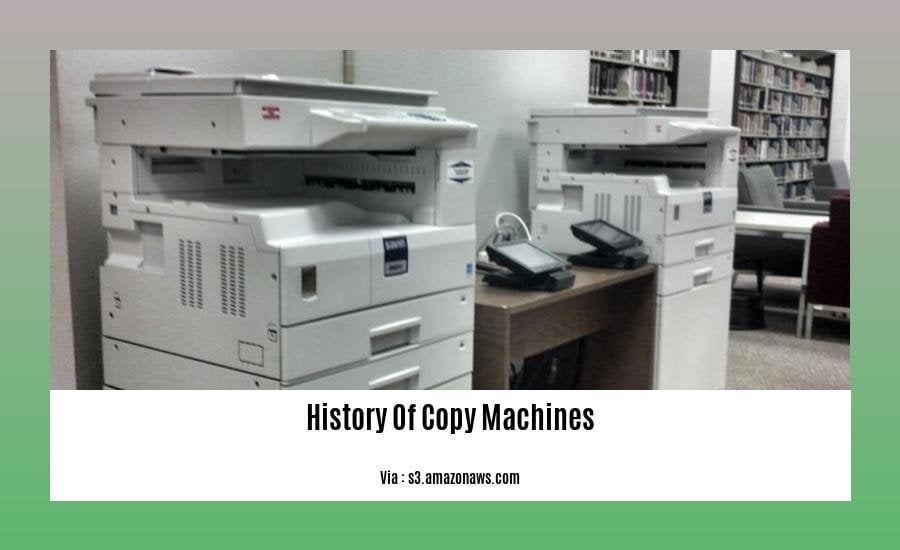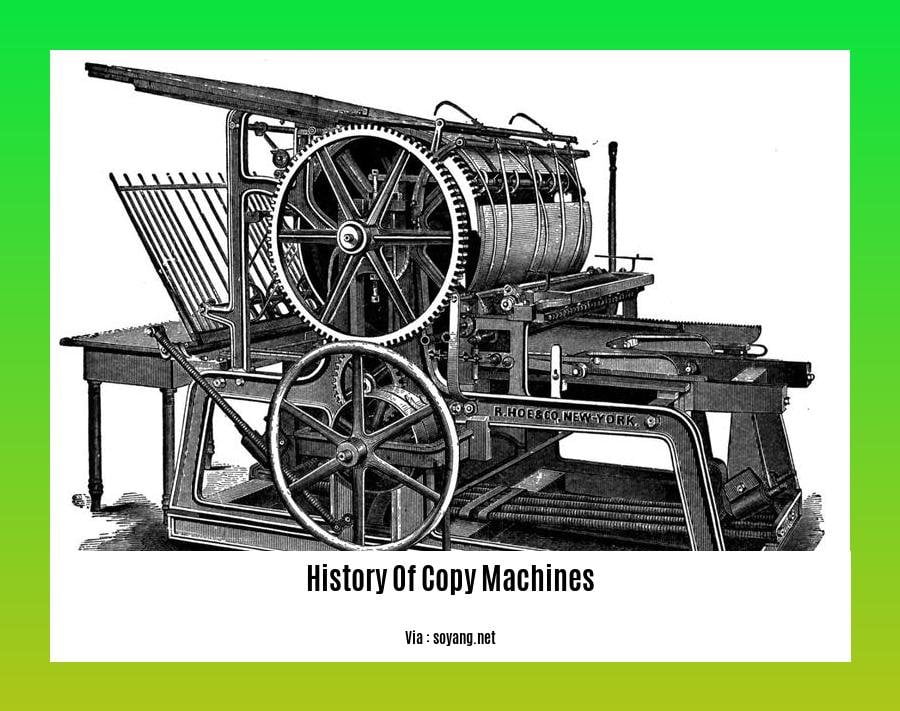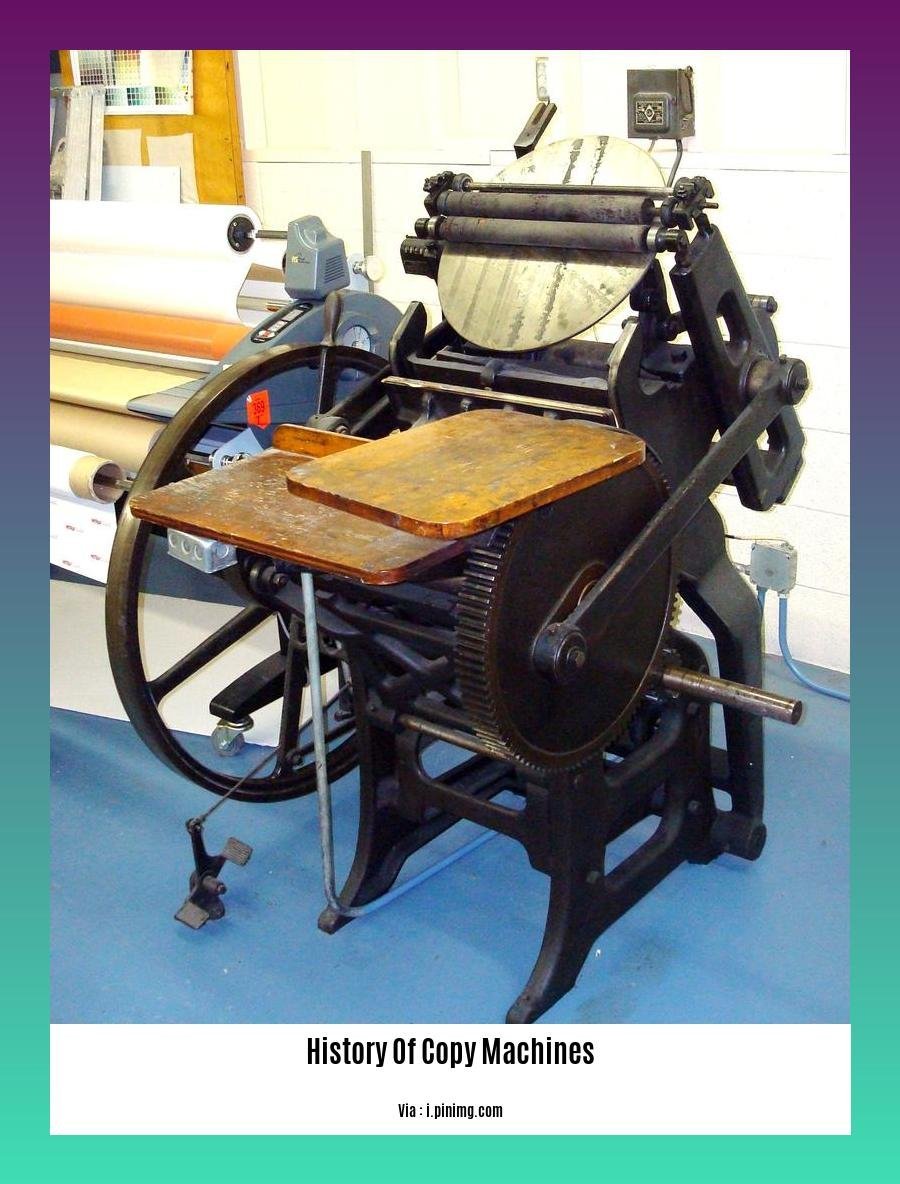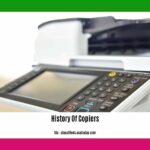Embark on a captivating journey through the annals of innovation as we delve into [A Technological Journey: Tracing the History of Copy Machines and Their Impact on Communication]. From humble beginnings to transformative breakthroughs, discover how this remarkable invention revolutionized the way we share and document information, leaving an indelible mark on the landscape of modern communication.
Key Takeaways:

- James Watt designed the book press, the earliest form of a copying machine, in 1780.
- The first-ever modern copying machine was the Thermo-Fax, which emerged in the 1950s.
- Xerox Corporation introduced the Haloid Xerox 914, the first office copier, in 1959.
- Prior to the invention of the copier, documents were duplicated manually by methods like photography, carbon copies, or mimeograph.
- Chester Carlson is credited with inventing and introducing the photocopier in 1937
A History of Copy Machines: A Technological Revolution in Communication
Ever wondered about the history of that trusty copy machine in your office? Let’s dive into a fascinating journey from the first copies to today’s digital wonders.
From Hand-written to Photocopied: The Early Days
In the pre-copier era, duplication meant manual labor. Handwritten copies, carbon papers, and mimeograph machines were the norm, with photography reserved for special occasions.
In 1780, James Watt’s book press offered the first glimpse of a copying mechanism, but it wasn’t until 1937 that Chester Carlson unveiled the photocopier, a true game-changer in document reproduction.
The 1950s: Birth of the Modern Copier
The 1950s marked the dawn of modern copy machines. The Thermo-Fax machine, using heat to transfer images, emerged as the first widely adopted copier.
A few years later, in 1959, Xerox Corporation introduced the Haloid Xerox 914, the world’s first office copier, revolutionizing the way documents were duplicated and distributed.
The Digital Revolution: A New Era of Copying
The 1980s ushered in the digital copier, transforming the copying landscape. These machines scanned documents electronically, allowing for high-quality copies, multiple copies, and even editing capabilities.
Today’s copiers are marvels of technology, integrating scanning, printing, faxing, and even cloud connectivity, making them indispensable tools in modern offices and homes.
The Impact of Copy Machines: A Legacy of Efficiency and Innovation
The invention of copy machines has had a profound impact on our communication and documentation practices. Here are some key ways copy machines changed the world:
Productivity Boost: Copying machines have significantly increased productivity by enabling quick and easy duplication of documents, reducing manual labor and saving time.
Widespread Access to Information: Before copiers, access to information was limited. With copiers, documents could be easily shared and disseminated, democratizing access to knowledge.
Accuracy and Quality: Copiers produce high-quality copies, eliminating errors and ensuring accuracy in document reproduction.
Cost-Effective Communication: Copying documents is cost-effective compared to traditional methods like printing or photography.
The journey of copy machines has been a remarkable one, evolving from simple hand-copying methods to sophisticated digital marvels. Today, they stand as a testament to human ingenuity and the power of innovation in shaping our communication landscape.
Did you know about the history of concrete timeline? The article offers insights into how concrete, one of the most versatile materials in the world, evolved throughout history.
Dive into the history of contemporary dance, a captivating journey through the evolution of this expressive art form, from its origins to the innovative movements that define it today.
In the realm of office technology, trace the history of copiers, from their humble beginnings to the sophisticated devices that revolutionized document reproduction, paving the way for efficient office operations.
The Dawn of Commercial Success: Xerox 914 Copier Revolutionizes Office Workflows
Imagine a world without copiers—a world where every document had to be painstakingly handwritten or duplicated using carbon paper. In this pre-Xerox era, the ability to quickly and easily reproduce documents was a distant dream.
Enter the Xerox 914, the brainchild of Chester Carlson, a patent attorney with a vision to revolutionize document reproduction. Introduced in 1959, the Xerox 914 was not just another copier; it was a game-changer that ushered in a new era of office efficiency and productivity.
The Xerox 914: A Revolutionary Invention
The Xerox 914 was the first commercially successful plain paper copier, capable of producing 100,000 copies per month—a remarkable feat at the time. Its speed, affordability, and ease of use made it an instant hit in offices worldwide.
But the Xerox 914’s impact extended far beyond its technical capabilities. It transformed the way businesses communicated and disseminated information. With the ability to quickly and cheaply reproduce documents, companies could now share information more easily, collaborate more effectively, and reach new heights of productivity.
Key Takeaways:
Commercial Success: The Xerox 914 was the first commercially successful plain paper copier, paving the way for widespread adoption of copying technology in offices.
Speed and Efficiency: With a copying speed of up to 100,000 copies per month, the Xerox 914 revolutionized document reproduction, enabling businesses to save time and resources.
Plain Paper Innovation: Unlike earlier copiers that produced copies on specialized paper, the Xerox 914 used plain paper, making the copying process more convenient and accessible.
Impact on Communication: The Xerox 914 transformed business communication by facilitating the rapid and easy sharing of documents, enhancing collaboration and productivity.
The Xerox Legacy: A Lasting Impact
The Xerox 914’s legacy extends beyond its initial success. It laid the foundation for the modern copier industry, inspiring a wave of innovation and competition. Today, copiers are indispensable tools in offices and homes worldwide, performing a multitude of tasks beyond simple copying, including printing, scanning, faxing, and cloud connectivity.
The Xerox 914 stands as a testament to human ingenuity and the power of innovation to transform industries and improve our lives. Its impact on communication and productivity is undeniable, leaving an indelible mark on the history of technology.
Citations:
[1] “Xerox 914 – Wikipedia.”
[2] “The Xerox 914 Plain Paper Copier | Smithsonian’s History Explorer.” https://historyexplorer.si.edu/resource/xerox-914-plain-paper-copier
From Analog to Digital: The Advent of Digital Copiers

In the realm of office technology, the advent of digital copiers marked a pivotal moment, revolutionizing the way we reproduce and distribute information. This technological leap propelled us from the limitations of analog copying methods into an era of efficiency, versatility, and precision.
Embracing the Digital Revolution
The 1980s ushered in a new chapter in the history of copiers, as digital technology took center stage. Unlike their analog predecessors, digital copiers harnessed the power of computers to store and manipulate digital data, opening up a world of possibilities.
Digital copiers not only replicated documents with remarkable accuracy but also introduced a range of functionalities that transformed them into versatile office powerhouses. Printing, scanning, and faxing capabilities were integrated into these machines, making them indispensable tools for modern workplaces.
Benefits Galore:
Enhanced Quality: Digital copiers produce crisp, high-resolution copies, eliminating the grainy, faded output of analog machines.
Multiple Copies: With digital technology, users can effortlessly produce multiple copies of a document without compromising quality.
Editing Capabilities: Digital copiers allow users to manipulate and edit digital images before printing, enhancing accuracy and professionalism.
Increased Efficiency: Digital copiers streamline the copying process, reducing the time and effort required to reproduce documents.
Cost-Effective: In the long run, digital copiers offer cost savings compared to analog models, thanks to their energy efficiency and reduced maintenance needs.
A Legacy of Innovation
The journey from analog to digital copiers epitomizes the relentless march of innovation in the world of technology. From the humble beginnings of manual copying methods to the sophisticated digital marvels of today, copiers have undergone a remarkable transformation.
Digital copiers have become an integral part of our modern communication landscape, enabling seamless document reproduction, sharing, and distribution. Their impact extends far beyond the office, reaching into homes, schools, and businesses of all sizes.
Key Takeaways:
- Digital copiers emerged in the 1980s, revolutionizing the way we copy and distribute information.
- Digital copiers store and manipulate digital data, offering superior quality, multiple copies, editing capabilities, and increased efficiency.
- Digital copiers integrate printing, scanning, and faxing functionalities, making them versatile office tools.
- Digital copiers offer cost savings compared to analog models due to energy efficiency and reduced maintenance needs.
- Digital copiers have transformed communication, enabling seamless document reproduction, sharing, and distribution across various sectors.
Sources:
[1] https://www.copyform.co.uk/blog/the-evolution-of-copiers-from-analog-to-digital
[2]
Contemporary Advancements and Future Prospects: Multifunction Devices and Beyond
Imagine a world where replicating documents was a tedious, time-consuming process involving manual labor or carbon paper. The invention of the copy machine revolutionized the way we create and share information. From its humble beginnings to its current sophisticated state, the copy machine has come a long way. Let’s delve into the exciting realm of contemporary advancements and future prospects in the world of multifunction devices.
A Glimpse into the Future: Multifunction Devices Take Center Stage
The future of copy machines lies in multifunction devices (MFDs) that combine the capabilities of multiple machines into a single, streamlined unit. These devices not only copy but also print, scan, fax, and even offer cloud connectivity, making them indispensable tools in modern offices and homes.
MFDs have become increasingly compact and affordable, making them accessible to businesses of all sizes. They are also becoming more energy-efficient, reducing their environmental impact.
Key Takeaways:
Multifunction devices (MFDs) are the future of copy machines, integrating various functions into a single, compact unit.
MFDs offer a range of benefits, including increased efficiency, cost savings, reduced environmental impact, and enhanced document security.
The latest MFDs incorporate cutting-edge technologies such as cloud connectivity, mobile printing, and advanced scanning capabilities, making them indispensable tools for modern businesses.
MFD manufacturers are continuously innovating to develop even more advanced and user-friendly devices, ensuring that these machines remain at the forefront of document management solutions.
Looking Ahead: Innovation and Sustainability Drive Future Advancements
As technology continues to advance, we can expect to see even more innovative features and capabilities in MFDs. These may include:
Artificial intelligence (AI): AI-powered MFDs can analyze and learn from usage patterns, optimizing performance and suggesting improvements.
Enhanced security: Advanced security features will protect sensitive data from unauthorized access, ensuring compliance with data protection regulations.
Sustainability: MFDs will become even more energy-efficient and environmentally friendly, reducing their carbon footprint.
Integration with other devices: MFDs will seamlessly integrate with other devices in the office, such as smartphones, tablets, and laptops, enabling users to print, scan, and fax from anywhere.
Embracing the Future of Document Management
The future of copy machines is bright, with MFDs leading the way. These versatile devices will continue to evolve, offering businesses a range of benefits that enhance productivity, efficiency, and sustainability. By embracing the latest advancements in MFD technology, businesses can stay ahead of the curve and optimize their document management processes.
Sources:
The Future of Multifunction Printers
Multifunction Printers: The Future of Document Management
FAQ
Q1: When was the copy machine invented?
A1: Chester Carlson invented the photocopier in 1937, introducing the technology to the world.
Q2: What was the first commercial office copier?
A2: The Haloid Xerox 914, introduced by Xerox Corporation in 1959, was the first office copier.
Q3: How did the copier revolutionize document duplication?
A3: Before the copier, documents were duplicated by hand, photography, carbon copies, or mimeograph. The copier brought a fast, economical, and efficient method of duplicating documents.
Q4: What was the significance of the Xerox 914 copier?
A4: The Xerox 914 copier, introduced in 1959, was the first successful commercial plain paper copier, revolutionizing the document-copying industry due to its speed, economy, and ability to produce up to 100,000 copies per month.
Q5: How did digital technology impact the evolution of copiers?
A5: In the 1980s, digital copiers introduced the ability to store and manipulate digital data, making copying, printing, scanning, and faxing documents more efficient and versatile. Digital technology eventually replaced analog technology in the copy business by the 1990s.
- China II Review: Delicious Food & Speedy Service - April 17, 2025
- Understand Virginia’s Flag: History & Debate - April 17, 2025
- Explore Long Island’s Map: Unique Regions & Insights - April 17, 2025
















